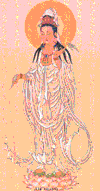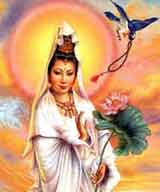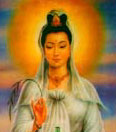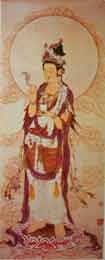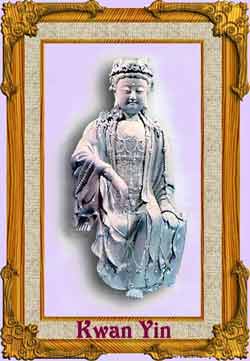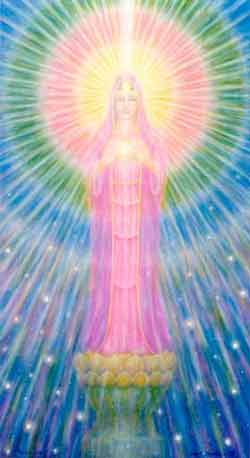Quan Yin
(Mystic Center)

Digital Prayer
Wheels
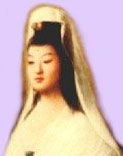 |
|||||
| Virtual
Altar dedicated to Quan Yin |
|||||
Quan
Yin (Kuan Yin) is the Chinese bodhisattva (Buddhistic prophet,
a true Enlightened One) to whom childless women turn for help. Kuan-yin,
whose name means "Who Contemplates the [Supplicating] Sound of the
World", along with Samantabhadra, Kshitigarbha (Di-cang) and Manjushri
(Wen-shu), is one of the four great bodishattvas of Buddhism. Kuan-yin
is identified as the male bodhisattva Avalokiteshvara, also known
as Chenresi in Tibetan, "One Who Hears the Cries of the World." |
|||||
| Quan Yin is one of the most universally beloved of deities in the Buddhist tradition. Also known as Kuan Yin, Quan'Am (Vietnam), Kannon (Japan), and Kanin (Bali), She is the embodiment of compassionate loving kindness. As the Bodhisattva of Compassion, She hears the cries of all beings. Quan Yin enjoys a strong resonance with the Christian Mary, the Mother of Jesus, and the Tibetan goddess Tara. In many images She is depicted carrying the pearls of illumination. Often Quan Yin is shown pouring a stream of healing water, the "Water of Life," from a small vase. With this water devotees and all living things are blessed with physical and spiritual peace. She holds a sheaf of ripe rice or a bowl of rice seed as a metaphor for fertility and sustenance. The dragon, an ancient symbol for high spirituality, wisdom, strength, and divine powers of transformation, is a common motif found in combination with the Goddess of Mercy. | |||||
In more recent representation, Kuan-yin is often depicted with distinct
feminine features, an effect of Taoistic and quanyin.jpg
Tantric influences from the 8th to 10th century. She is often rendered
as the Thousand Armed, Thousand Eyed bodhisattva, and in a form
inspired by the Virgin Mary (the mother of Jesus), and the Tibetan
goddess Tara.
There are numerous legends that recount the miracles that Quan Yin
performs to help those who call on Her. The many stories and anecdotes
featuring this Goddess serve to convey the idea of an enlightened
being who embodies the attributes of an all pervasive, all consuming,
unwavering loving compassion and who is accessible to everyone. |
|||||
Shambala
Shambala, known as the "Hidden Kingdom," is thought of in Tibet as a community where perfect and semiperfect beings live and are guiding the evolution of humankind. Shambala is considered to be the source of the Kalacakra, which is the highest and most esoteric branch of Tibetan mysticism. The Buddha preached the teachings of the Kalacakra to an assembly of holy men in southern India. Afterwards, the teachings remained hidden for 1,000 years until an Indian yogi-scholar went in search of Shambala and was initiated into the teachings by a holy man he met along the way.
The Kalacakra then remained in India until it made its way to Tibet in 1026. Since then the concept of Shambala has been widely known in Tibet, and Tibetans have been studying the Kalacakra for the least 900 years, learning its science, practicing its meditation, and using its system of astrology to guide their lives. As one Tibetan lama put it, how could Shambala be the source of something which has affected so many areas of Tibetan life for so long and yet not exist?

(Click on images for full-sized view. )
Sacred Place list
*Water:
For I am mistress of the Southern Sea.
* A picture of me: For I am your friend feel the love
as I place my many arms around you, to love and hold you.
* A small branch from a tree:
symbloizing a willow branch for the divine nectar of life.
* A vase: symbolizing the nectar of compassion and wisdom
* A Feather: symbolizing a dove to bring you peace.
* A book: symbolizing all the teaching you need to receive.
* A gem stone: For empowernent and to lead you out of your problems.
* Extra things not needed, but will make things work better!!
* For the first 7 days.
* 13 red gem stones for the 13 power spots {garnet, ruby, red tigers
eye}
* red flower and or gem essences.
* Red aromatherapy perfume.
News Groups
alt.meditation.quanyin
alt.religion.buddhism
alt.religion.buddhism.tibetan
talk.religion.buddhism
Other News groups
Other Web Sites
© 2001-2007
Compiled by: Glenn Welker
Last Updated: August 6, 2007
This
site has been accessed 10,000,000
 times since February 8, 1996.
times since February 8, 1996.

